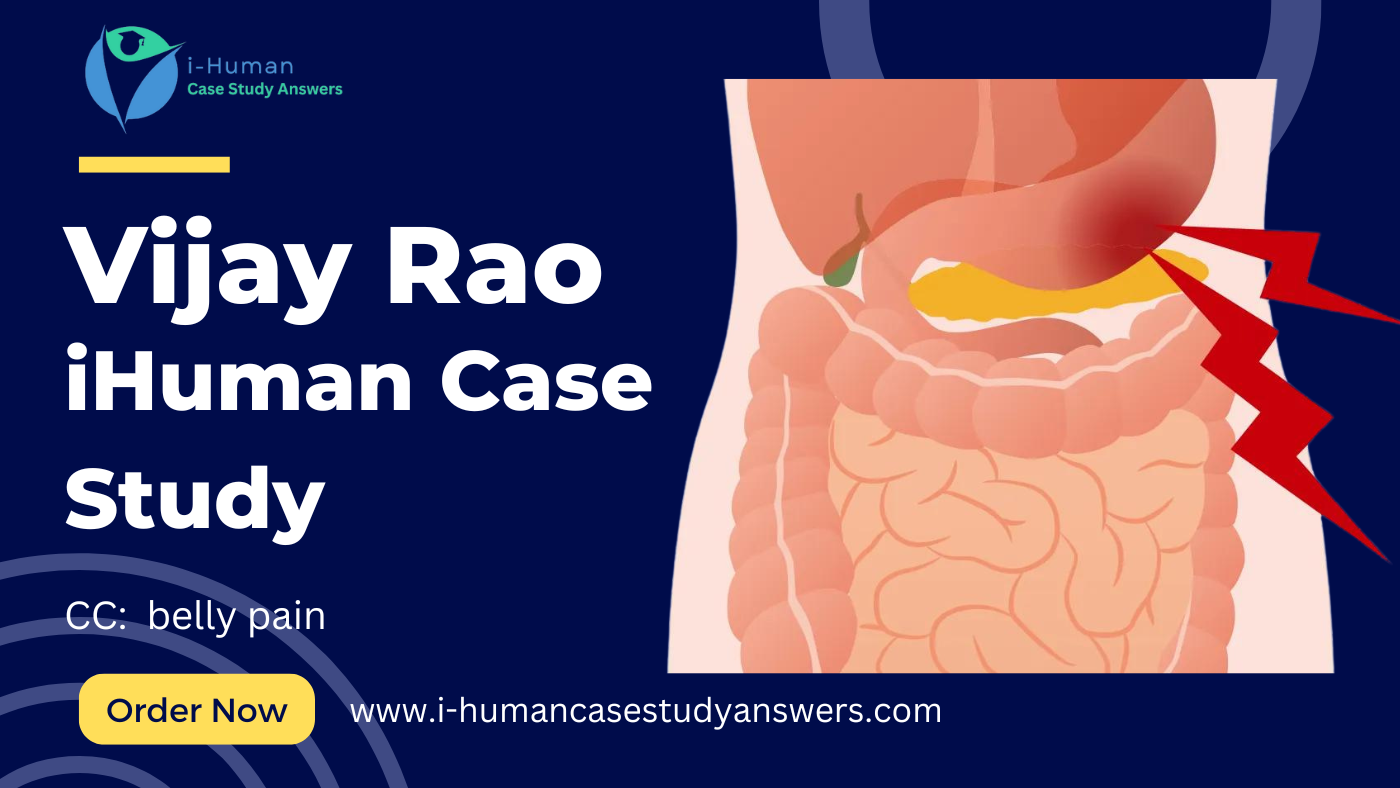Welcome to another detailed analysis in our ongoing series on iHuman case studies. This week, we delve into the case of Vijay Rao, a 60-year-old male presenting with belly pain. Our goal is to guide medical students and professionals through the critical thinking and diagnostic process involved in such a case. This case study emphasizes the importance of thorough history taking and systematic examination.
Table of Contents
Patient Profile
- Name: Vijay Rao
- Age: 60
- Height: 188 cm (6’2″)
- Weight: 204 lb (92.7 kg)
- Reason for Encounter: Belly pain
Vijay Rao iHuman Case Study -Initial Encounter and History Taking
The initial encounter with Vijay Rao involves a detailed history to uncover potential causes of his abdominal pain. Here are 26 key questions that should be asked during the history-taking phase:
- Onset of Pain: When did the pain start?
- Pain Location: Where exactly is the pain located?
- Pain Duration: How long does the pain last?
- Pain Character: Can you describe the pain (sharp, dull, burning, cramping)?
- Pain Radiation: Does the pain radiate to other parts of the body?
- Pain Severity: On a scale of 1 to 10, how severe is the pain?
- Pain Aggravation: What activities or positions worsen the pain?
- Pain Relief: What alleviates the pain (medication, rest, position)?
- Associated Symptoms: Have you experienced nausea, vomiting, diarrhea, or constipation?
- Appetite Changes: Have you noticed any changes in your appetite?
- Weight Changes: Have you had any recent weight loss or gain?
- Fever: Have you had any fevers or chills?
- Bowel Habits: Have you noticed any changes in your bowel movements?
- Urinary Symptoms: Any issues with urination, such as pain or frequency?
- Medical History: Do you have a history of gastrointestinal diseases (e.g., GERD, IBS, Crohn’s disease)?
- Surgical History: Have you had any abdominal surgeries?
- Medications: What medications are you currently taking, including over-the-counter drugs?
- Allergies: Do you have any known allergies?
- Dietary Habits: Can you describe your typical diet?
- Alcohol Use: Do you consume alcohol? If so, how much and how often?
- Tobacco Use: Do you smoke or use tobacco products?
- Family History: Is there a family history of gastrointestinal issues?
- Travel History: Have you traveled recently, especially to areas with different sanitation standards?
- Stress Levels: Have you been experiencing high levels of stress or anxiety?
- Physical Activity: What is your level of physical activity?
- Other Symptoms: Have you experienced any other unusual symptoms or changes in health?
Vijay Rao iHuman case study
The Vijay Rao iHuman case study is a vital learning resource for medical students and healthcare professionals. It offers a deep dive into clinical reasoning, patient-centered care, and evidence-based diagnostic and treatment processes. This article provides a detailed exploration of the case study, emphasizing its educational value and practical applications.
1. Patient Encounter Overview: Vijay Rao
The Vijay Rao iHuman case study introduces a patient presenting with specific complaints that demand a systematic diagnostic approach. The case begins with a thorough patient history, focusing on clinical symptoms and the outcomes of initial assessments. This step highlights the critical role of history-taking and targeted physical exams in identifying potential underlying conditions. By carefully documenting and analyzing the patient’s information, healthcare providers can establish a clear picture of the patient’s health status.
2. Diagnostic Process
The diagnostic process in the Vijay Rao case underscores the importance of clinical reasoning and analytical skills. It involves:
- Analyzing Symptoms: A detailed examination of the patient’s complaints to identify potential causes.
- Differential Diagnosis: Clinicians must evaluate various possible conditions, ruling out less likely options.
- Diagnostic Tools: Lab tests and imaging studies are pivotal in narrowing down diagnoses and ensuring accuracy. These tools provide objective data that complement clinical observations.
This structured approach ensures that the diagnosis is both accurate and comprehensive, minimizing the risk of oversight.
3. Assessment Reports
Assessment reports in the Vijay Rao case offer a detailed performance summary, including:
- Vital Signs: Baseline physiological data crucial for identifying abnormalities.
- Physical Exam Findings: Targeted examinations provide clues to underlying conditions.
- Lab Results: Blood tests, imaging, and other diagnostic tools reveal critical insights into the patient’s health.
These data points are integral to creating a detailed problem list. Comprehensive documentation not only aids in diagnosis but also ensures that subsequent treatment plans adhere to evidence-based practices.
4. Management Plan for Vijay Rao
The management plan for Vijay Rao is designed to address the patient’s condition holistically. Key components include:
- Interventions: Specific medical or procedural interventions tailored to the diagnosis.
- Medications: Prescriptions based on evidence-based guidelines to manage symptoms or treat the underlying condition.
- Patient Education: Educating the patient about their condition, treatment options, and necessary lifestyle modifications.
- Follow-Up Schedule: Regular monitoring and adjustments to the management plan as needed to ensure optimal outcomes.
This comprehensive approach underscores the importance of patient engagement and ongoing care.
5. Educational Value and Insights
The Vijay Rao iHuman case study is an invaluable educational tool for medical students and practitioners. It highlights several critical aspects of clinical practice, including:
- Clinical Reasoning: The ability to integrate patient history, physical exams, and diagnostic tools.
- Patient-Centered Care: Emphasizing empathy, clear communication, and individualized care plans.
- Evidence-Based Practice: Ensuring that all diagnostic and treatment decisions are grounded in the latest clinical guidelines.
By engaging with this case study, learners gain practical insights into managing real-world clinical scenarios. The Vijay Rao case exemplifies the art and science of medicine, making it an essential component of medical education.
Vijay Rao iHuman Case Study- Physical Examination
Following a comprehensive history, a physical examination is crucial. The examination should include:
- Inspection: Check for any visible abnormalities, such as distension or scars.
- Auscultation: Listen for bowel sounds to assess gut motility.
- Palpation: Gently palpate the abdomen to identify tenderness, masses, or organomegaly.
- Percussion: Determine the presence of fluid or air in the abdominal cavity.
Vijay Rao iHuman Differential Diagnosis
Based on the history and physical examination, potential diagnoses for Vijay Rao’s belly pain may include:
- Gastroesophageal Reflux Disease (GERD)
- Peptic Ulcer Disease
- Cholecystitis
- Pancreatitis
- Appendicitis
- Diverticulitis
- Irritable Bowel Syndrome (IBS)
- Infectious Gastroenteritis
- Abdominal Aortic Aneurysm (AAA)
Diagnostic Tests
To narrow down the differential diagnoses, the following tests may be ordered:
- Blood Tests: Complete blood count (CBC), liver function tests (LFTs), amylase and lipase levels.
- Imaging: Abdominal ultrasound, CT scan, or MRI to visualize the abdominal organs.
- Endoscopy: Upper or lower GI endoscopy to examine the digestive tract.
- Stool Tests: To check for infections or blood in the stool.
Conclusion
The case of Vijay Rao highlights the importance of a methodical approach to diagnosing abdominal pain. Through detailed history taking, thorough physical examination, and appropriate diagnostic testing, healthcare providers can effectively identify the underlying cause of abdominal pain and formulate a treatment plan. This case study serves as a valuable educational tool for medical students and professionals, enhancing their clinical reasoning and diagnostic skills.
FAQ: Vijay Rao iHuman Case Study Answers
What is the Vijay Rao iHuman case study about?
The Vijay Rao iHuman case study involves a 60-year-old male presenting with belly pain. The case focuses on the diagnostic process, including history taking, physical examination, differential diagnosis, and appropriate diagnostic tests.
What is iHuman Case Study Answers?
iHuman Case Study Answers is a resource providing detailed guides and answers for iHuman case studies. Our goal is to support medical students and professionals in honing their clinical reasoning and diagnostic skills.
How can I access the full Vijay Rao case study guide?
You can access the full guide by visiting our website i-human Case Study Answers and navigating to the Vijay Rao case study section.
What are the key questions to ask during history taking for Vijay Rao’s case?
Key questions include the onset, location, duration, character, and severity of the pain, associated symptoms, medical and surgical history, medications, allergies, dietary habits, and lifestyle factors.
Why is it important to ask about dietary habits and lifestyle factors?
Dietary habits and lifestyle factors can significantly impact gastrointestinal health and may help identify triggers or underlying causes of abdominal pain.
What should be included in the physical examination for abdominal pain?
The physical examination should include inspection, auscultation, palpation, and percussion of the abdomen to identify any abnormalities, tenderness, masses, or fluid accumulation.
How can the physical examination findings influence the differential diagnosis?
Physical examination findings can provide clues about the underlying cause of the pain, such as localized tenderness indicating appendicitis or abnormal bowel sounds suggesting a bowel obstruction.
What diagnostic tests are recommended for Vijay Rao’s case?
Recommended tests may include blood tests (CBC, LFTs, amylase, lipase), imaging studies (ultrasound, CT scan, MRI), endoscopy, and stool tests.
How do you decide which diagnostic tests to order?
The decision is based on the patient’s history, physical examination findings, and the most likely differential diagnoses. Tests are chosen to confirm or rule out these potential diagnoses.
What are the potential differential diagnoses for Vijay Rao’s belly pain?
Potential diagnoses include GERD, peptic ulcer disease, cholecystitis, pancreatitis, appendicitis, diverticulitis, IBS, infectious gastroenteritis, and abdominal aortic aneurysm.
How can I narrow down the differential diagnoses?
Differential diagnoses can be narrowed down by correlating the history and physical examination findings with the results of diagnostic tests.
How can iHuman Case Study Answers help with the Vijay Rao case?
We provide detailed explanations, step-by-step guides, and sample answers to help you understand the case, improve your diagnostic skills, and prepare for exams.
Do you offer support for other iHuman cases as well?
Yes, we offer comprehensive support for a wide range of iHuman case studies. Visit our website for more information on the cases we cover.



